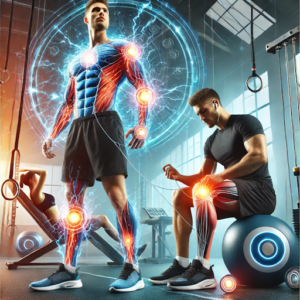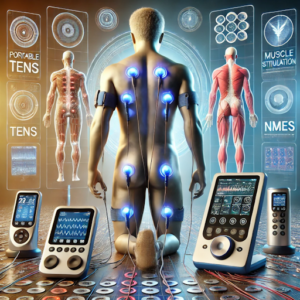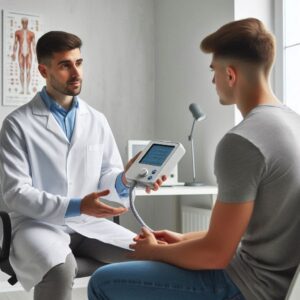Maximise Your Muscle Recovery with Electrotherapy Techniques
Electrotherapy for muscle revitalisation represents an advanced therapeutic approach that uses electrical energy to stimulate the body’s tissues effectively. This innovative method is integral to modern physical rehabilitation and wellness strategies. Contrary to being a mere contemporary trend, the roots of electrotherapy run deep, with ancient civilisations utilising electrical phenomena for healing purposes. In today’s context, electrotherapy comprises a range of specialised techniques, including transcutaneous electrical nerve stimulation (TENS), neuromuscular electrical stimulation (NMES), and interferential current therapy. Each method is tailored to address distinct health challenges, providing targeted solutions for individuals seeking relief and rehabilitation.
The advancements in our understanding of human physiology and effective pain management strategies have fueled the evolution of electrotherapy. This growth has firmly established electrotherapy as a crucial component of contemporary therapeutic practices. Its resurgence in popularity can be linked to its non-invasive characteristics and a growing body of evidence endorsing its efficacy. As more people turn to non-pharmacological options for pain management, electrotherapy emerges as a compelling alternative, delivering significant relief from muscle discomfort, accelerating recovery from injuries, and enhancing overall physical wellness.
Electrotherapy’s allure lies in its ability to diminish discomfort and its potential to improve muscle function and foster the healing process. Delving deeper into the mechanisms that underlie electrotherapy, we uncover a versatile treatment that offers numerous advantages for individuals eager to optimise their physical health and well-being.
Essential Insights into the Benefits of Electrotherapy
- Electrotherapy is a cutting-edge treatment modality that employs electrical energy to stimulate muscle tissue, thus promoting healing and recovery.
- This therapeutic technique transmits electrical impulses to targeted areas of the body, significantly reducing pain, enhancing muscle strength, and improving overall blood circulation.
- Among its various benefits, electrotherapy provides effective pain relief, promotes muscle relaxation, increases the range of motion, and accelerates tissue healing processes.
- A variety of electrotherapy devices are available, including TENS units, EMS devices, and ultrasound machines. Each offers unique therapeutic benefits tailored to specific applications.
- When utilising electrotherapy devices, it is crucial to adhere to the manufacturer’s guidelines and consult a healthcare professional, particularly if you have existing health concerns or underlying medical conditions.
 Understanding How Electrotherapy Heals and Restores Muscle Function
Understanding How Electrotherapy Heals and Restores Muscle Function
Electrotherapy involves applying electrical currents to the body through electrodes strategically placed on the skin, which triggers a range of physiological responses. These electrical impulses interact directly with nerve fibres and muscle tissues, resulting in various therapeutic effects. For example, TENS therapy utilises low-voltage signals designed to block pain signals from reaching the brain, effectively alleviating chronic pain conditions and improving quality of life.
This therapeutic process mimics the body’s inherent pain-relief mechanisms, encouraging the release of endorphins—natural pain-relieving compounds that decrease pain perception. On the other hand, neuromuscular electrical stimulation (NMES) directly targets muscle fibres, stimulating motor neurons to induce muscle contractions. This process plays a vital role in muscle strengthening and is essential in rehabilitation following injuries or surgical procedures.
The combination of pain relief and muscle activation highlights the diverse capabilities of electrotherapy as a therapeutic intervention. Research continues to reveal the intricate effects of electrical stimulation on cellular processes and tissue repair mechanisms, and electrotherapy is increasingly recognised as a viable long-term solution for muscle recovery and rejuvenation.
 Exploring the Diverse Range of Electrotherapy Devices for Optimal Healing
Exploring the Diverse Range of Electrotherapy Devices for Optimal Healing
Electrotherapy devices are designed with varying functionalities and applications to meet a broad spectrum of therapeutic needs. Among the most widely used devices is the TENS unit, renowned for its effectiveness in pain management. These portable devices often feature multiple settings, enabling users to adjust the intensity and frequency of electrical impulses to their comfort levels.
TENS units are particularly beneficial for home use, providing a convenient means of managing chronic pain conditions such as arthritis or lower back pain without relying solely on pharmaceutical interventions. In contrast, NMES devices are engineered explicitly for muscle stimulation and rehabilitation, ranging from simple handheld models to sophisticated systems utilised in clinical environments.
Many NMES devices come with programmable settings that allow healthcare professionals to customise treatment protocols based on each patient’s unique needs. Additionally, hybrid devices that amalgamate the functionalities of TENS and NMES offer comprehensive solutions for pain relief and muscle recovery, catering to diverse therapeutic requirements. As technological advancements continue, we can anticipate the emergence of more sophisticated electrotherapy devices that further enhance user experience and treatment outcomes.
Strategies for Using Electrotherapy to Achieve Maximum Muscle Recovery
Incorporating electrotherapy into your muscle recovery regimen necessitates a thoughtful approach to achieving optimal results while minimising any potential discomfort. Before commencing any electrotherapy regimen, it is essential to consult with a healthcare professional or physiotherapist. They can assist you in selecting the most suitable device for your specific needs and help develop a personalised treatment plan that aligns with your recovery objectives.
Once you have chosen a device, familiarising yourself with its functionalities is crucial. Most electrotherapy units come equipped with user manuals that offer comprehensive instructions on the correct placement of electrodes and guidance on adjusting settings for optimal results. Proper electrode placement ensures that electrical impulses target the intended muscles and nerve fibres effectively.
It is advisable to start with lower-intensity settings and gradually increase them as you become more comfortable with the sensation. Typical treatment sessions last between 20 and 30 minutes, although this duration can be tailored based on individual tolerance levels and therapeutic goals. Consistency is key to maximising the benefits of electrotherapy; incorporating it into your routine several times per week can significantly enhance muscle strength and recovery rates.
Monitoring your progress and making necessary adjustments to your treatment plan will optimise the therapeutic effects of electrotherapy, empowering you to harness its full potential in your muscle recovery journey.
 Crucial Safety Precautions to Consider Before Using Electrotherapy
Crucial Safety Precautions to Consider Before Using Electrotherapy
While electrotherapy is generally regarded as a safe treatment option, several precautions must be observed to ensure its safe and practical application. Individuals with pre-existing medical conditions such as epilepsy or heart disease, as well as those with implanted devices like pacemakers, should refrain from using electrotherapy without prior consultation with a healthcare professional. The electrical impulses generated by electrotherapy could potentially interfere with these devices or exacerbate existing conditions, leading to severe complications.
Pregnant women should also seek medical advice before using electrotherapy, as the effects during pregnancy have not been thoroughly studied. Another critical consideration is skin sensitivity; some individuals may experience irritation or allergic reactions at the electrode application sites. To mitigate the risk of skin irritation, utilise hypoallergenic electrodes and ensure that the skin is clean and dry before application.
Additionally, it is essential to avoid placing electrodes on areas with broken skin, rashes, or wounds, as this could lead to further irritation or possible infection. Listening to your body during treatment is vital—if you experience discomfort or any unusual reactions, you should discontinue use immediately and consult a healthcare provider. By adhering to these guidelines, you can safely enjoy the numerous benefits of electrotherapy.
Integrating Electrotherapy into Your Comprehensive Muscle Recovery Plan
Incorporating electrotherapy into your recovery routine can significantly enhance muscle recuperation and elevate overall physical performance. Whether you are an athlete recovering from surgery or grappling with chronic pain, electrotherapy serves as an effective, non-invasive strategy for enhancing muscle function and expediting recovery.
To maximise its effectiveness, it is crucial to integrate electrotherapy into a well-rounded recovery plan that includes traditional rehabilitation methods such as physiotherapy and massage therapy. By combining these approaches, you can create a holistic healing strategy that addresses immediate pain relief and promotes long-term muscle health. Electrotherapy is pivotal in helping you achieve your fitness and recovery goals by reducing pain, enhancing circulation, and facilitating muscle activation.
To fully capitalise on electrotherapy’s benefits, it is essential to adhere to best practices, seek guidance from healthcare professionals, and maintain a consistent schedule for your sessions. As research in electrotherapy advances, its therapeutic potential is expected to expand, solidifying its position as a cornerstone in muscle recovery and physical wellness. Electrotherapy is not merely a temporary remedy but a sustainable solution for those dedicated to improving their health and vitality.
In addition to its muscle recovery benefits, electrotherapy can be complemented by other therapeutic modalities for enhanced results. One such modality is cupping therapy, which has gained popularity for its efficacy in improving circulation and alleviating muscle tension. To explore how cupping therapy can synergise with electrotherapy, consider reading “Cupping Therapies: Unveiling the Mysteries.”
Common Questions Answered About Electrotherapy
What is electrotherapy for muscle recovery?
Electrotherapy is a therapeutic technique that uses electrical stimulation to alleviate pain, enhance muscle strength, and expedite healing in individuals recovering from injuries or experiencing chronic muscle discomfort.
How does electrotherapy function effectively?
Electrotherapy sends electrical impulses through the skin to the targeted muscles, which helps relieve pain, improve circulation, and induce beneficial muscle contractions, contributing to overall recovery.
What are the primary advantages of electrotherapy for muscles?
Electrotherapy offers many benefits, including pain reduction, increased muscle strength and endurance, enhanced mobility, and a faster recovery timeline from muscle injuries, making it a valuable tool for rehabilitation.
Are there any associated risks with muscle electrotherapy?
Electrotherapy is generally safe when performed correctly by trained professionals. However, it is crucial to follow established healthcare guidelines to minimise potential risks associated with its use.
Who can derive benefits from electrotherapy?
Electrotherapy is beneficial for individuals experiencing muscle pain, weakness, or injury. It is also an effective rehabilitation tool following surgery or trauma, helping individuals regain strength and functionality.
What potential side effects can occur from electrotherapy?
Electrotherapy is not recommended for pregnant women, individuals with pacemakers or other implanted devices, or those with specific skin conditions. If you have any concerns, it is advisable to consult a healthcare provider before using electrotherapy.
Brought to you by: Electrotherapy Preston
The Article: Muscle Revitalisation with Electrotherapy appeared first on https://mcrtherapies.co.uk
The Article Muscle Revitalisation with Electrotherapy appeared first on https://mcrtherapies.com/
The Article Muscle Revitalisation with Electrotherapy Was Found On https://limitsofstrategy.com/
The Article Muscle Revitalisation with Electrotherapy First Appeared ON
: https://ad4sc.com
Comments are closed